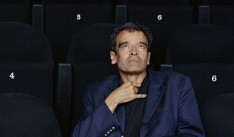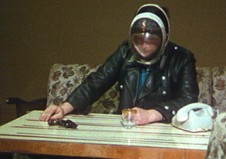Wie man sieht (As You See) – In memory of filmmaker Harun Farocki

Harun Farocki (c) Hertha Hurnaus
Wednesday January 14, 2015, 7:00 pm
The Goethe-Institut Los Angeles and Los Angeles Filmforum present
Wie man sieht (As You See) –
In memory of filmmaker Harun Farocki
Screening 1: Leben: BRD (How to Live in the FRG)
Film Series
Wednesdays, January 14th through March 4th 2015
Goethe-Institut Los Angeles, 5750 Wilshire Blvd. Suite 100, Los Angeles, CA 90036
German with English subtitles
Free admission, but RSVP needed, by email to rsvp@losangeles.goethe.org or the 323.525.3388
Harun Farocki – the director whose perspicacious cinematic essays analyzed the new media world – died in July 2014. With his radical way of looking at things Farocki strove to endow images with their own form of self-will, to expose their political and cultural coding.
Farocki lived and worked in Berlin as a filmmaker, artist and writer. His essay and observational films question the production and perception of images, decoding film as a medium and examining how audiovisual culture is related to history, politics, technology and war.
His projects have been shown in festivals and solo, group and retrospective exhibitions worldwide at important events and international institutions, including the 2010 São Paulo Biennial, Documenta X and XXII in Kassel, Tate Modern in London, MACBA in Barcelona, Museum Ludwig in Cologne and the Jeu de Paume in Paris.
All films in this series are in German with English Subtitles, unless otherwise noted.
For more event information: info@losangeles.goethe.org, or +1 323 525-3388
Tickets: Free, but please RSVP due to limited seating.
$1 validated parking (for events only) on weekdays after 6:00 pm and all day on weekends in the Wilshire Courtyard West underground garage-P1.
Special Thanks to Daniel Chaffey of the Goethe-Institut Los Angeles and Lucas Quigley for organizing this series.

Leben: BRD (How to Live in the FRG)
Leben: BRD (How to Live in the FRG)
1990, 88 min. color, German with English subtitles. Digital.
"The author assembles a genre picture of the contemporary FRG with shots of scenes where life is rehearsed, ability/durability is tested. Wherever one looks, people appear as actors playing themselves; they take on roles. A play in the theater of life made up of training courses, fitness tests for things and people. Be it in birth preparation classes for expectant parents or in practice runs for sales talks, on the military training ground or during role-plays for educational purposes. Everywhere the incessant effort to be prepared for the emergency of "reality" can be felt. How To Live In The FRG assembles out of a wealth of details a picture of a society in which childbearing and dying, crying and taking care of people, crossing streets and killing are taught and learned in state or private institutions, indeed have to be learned. The real mechanical ballet is not danced by machines but by people, who move to a music that feeds on bombastic phrases from the realms of social work, bureaucracy and therapy. All together, the collected scenes appear to support the view that a mentality of insurance and providing for the future prevails in the FRG, a country in which happiness as well as misery are supposed to be disciplined by means of social techniques and freed from any measure of unpredictability. And yet How To Live In The FRG goes beyond such an interpretation. The participants in the games, tests, and therapy sessions are not degraded into pieces of evidence for some theory or other. They retain, to varying degrees, something of their dignity. This is a result of Farocki's working method: he has edited the scenes in such a way that even the most nonsensical occurrences as it were explain themselves."
(D. Leder) - http://farocki-film.de/flash/index.html
